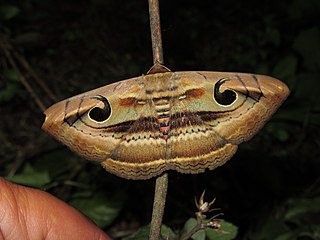
The evergreen bagworm, commonly known as bagworm, eastern bagworm, common bagworm, common basket worm, or North American bagworm, is a moth that spins its cocoon in its larval life, decorating it with bits of plant material from the trees on which it feeds.

The Psychidae are a family of the Lepidoptera. The bagworm family is fairly small, with about 1,350 species described. Bagworm species are found globally, with some, such as the snailcase bagworm, in modern times settling continents where they are not native.
The wattle bagworm is a species of moth in the family Psychidae. In southern Africa it is a pest of the black wattle which is grown largely as a source of vegetable tannin. Kotochalia junodi is indigenous to Southern Africa, where it originally fed on indigenous relatives of the wattle.
Eumeta crameri is a bagworm moth of the family Psychidae. It was described by John O. Westwood in 1854 and has worldwide distribution in tropical and subtropical habitats, including India, Bangladesh, Sri Lanka, New Zealand and Puerto Rico.

The Coleophoridae are a family of small moths, belonging to the huge superfamily Gelechioidea. Collectively known as case-bearers, casebearing moths or case moths, this family is represented on all continents, but the majority are found in temperate areas of the Northern Hemisphere. They are most common in the Palearctic, and rare in sub-Saharan Africa, South America, and Australia; consequently, they probably originated in northern Eurasia. They are relatively common in houses, they seek out moist areas to rest and procreate.

Olene mendosa, the brown tussock moth or hairy tussock moth, is a moth of the family Erebidae. The species was first described by Jacob Hübner in 1823. It is found in India, Bangladesh, Sri Lanka, Indonesia, Taiwan, Thailand and Australia.

Apterona helicoidella is a moth of the Psychidae family. It is widely distributed in Europe, from Portugal through most of central Europe and the Alps, up to the Ural. It is also found on the Balkan and in Turkey. It was introduced in the United States by accident during the 1940s. It is now found in many mid-Atlantic states, including Pennsylvania, and has also been reported in the Pacific coastal states, as well as Colorado, Michigan, Nevada, Utah and Idaho. It has been collected in Ontario as well.

Cryptophlebia ombrodelta, the litchi fruit moth or macadamia nut borer, is a moth of the family Tortricidae. The species was first described by Oswald Bertram Lower in 1898. It is native to India, Sri Lanka, Nepal, Indonesia, China, Taiwan, Vietnam, Thailand, western Malaysia, New Guinea, the Philippines, Japan, Guam, the Caroline Islands, Australia and has been introduced to Hawaii.

Saunders' case moth or the large bagworm is a moth of the Psychidae family. It is known from the eastern half of Australia, including Tasmania.
Archips micaceana is a moth of the family Tortricidae. It is found in China, Hong Kong, southern Vietnam, Burma, and northern Thailand. It is a minor pest of many agricultural crops.

Spirama retorta, the Indian owlet-moth, is a moth of the family Erebidae. The species was first described by Carl Alexander Clerck in 1764. It is found in China, Korea, Japan (Honshu), India, Nepal, Bangladesh, Thailand, Cambodia, Myanmar, Vietnam, Taiwan, Sri Lanka, Malaysia, the Philippines (Luzon), Indonesia ,Japan.

Acanthopsyche is a genus of moths in the Psychidae family. The genus was named by the Dutch entomologist Franciscus J.M. Heylaerts.
Indarbela quadrinotata, the bark-eating caterpillar, is a moth in the family Cossidae. It is found in India and Sri Lanka. It was described by Francis Walker in 1856.

Uromycladium is a genus of rust fungi in the family Pileolariaceae. It was circumscribed by mycologist Daniel McAlpine in 1905. The genus was established by McAlpine for rusts on Acacia with teliospores that clustered at the top of a pedicel.

Falcataria falcata, commonly known as the Moluccan albizia, is a species of fast-growing tree in the family Fabaceae. It is native to the Maluku Islands, New Guinea, the Bismarck Archipelago, and the Solomon Islands. It is cultivated for timber throughout South Asian and Southeast Asian countries. This tree is considered to be invasive in Hawaii, American Samoa and several other island nations in the Pacific and Indian Oceans. It reaches about 30 m (100 ft) tall in nature, and has a massive trunk and an open crown.
Eumeta variegata, commonly known as the paulownia bagworm or cotton bag worm, is a moth of the family Psychidae. The species was first described by Snellen in 1879. It is found in Japan, Papua New Guinea, India, the Solomon Islands and Sri Lanka.

Metisa plana is a moth of the family Psychidae first described by Francis Walker in 1883. It is found in Sumatra, Malaysia and Sri Lanka. It is a major pest on Elaeis guineensis, the African oil palm.
Acanthopsyche subteralbata is a moth of the family Psychidae first described by George Hampson in 1897. It is found in India and Sri Lanka.
Euwallacea similis, is a species of weevil native in the Oriental region through to Australia but shows a cosmopolitan distribution due to introduction to many parts of the world.
Mahasena corbetti, the coconut case caterpillar, is a polyphagous species of bagworm. This species is classified as leaf-eating pest caterpillars that produce tough silk out of their bags from dried foliage. Currently, M. corbetti is considered a ‘pest of quarantine importance’ in multiple countries and is included on the list of dangerous pests in the Malaysian plant quarantine act.












